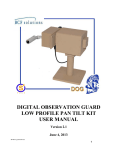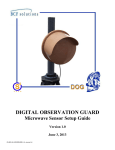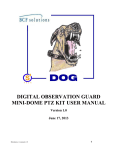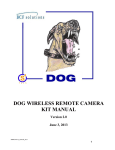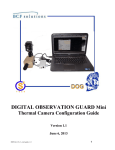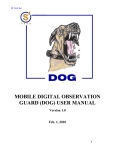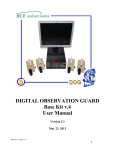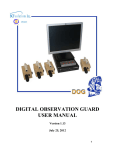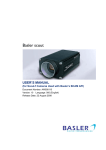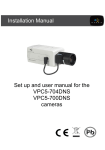Download Mini PTZ user manual
Transcript
DIGITAL OBSERVATION GUARD HIGH PERFORMANCE LOW PROFILE PTZ KIT USER MANUAL Version 2.2 May 17, 2013 DPTZ-Kit-1/2-v1_manual-v2.2 Table of Contents High Performance Low Profile PTZ Kit Description ................................................................................... 3 High Performance Low Profile PTZ Unit Basic Operation.......................................................................... 4 Mounting the High Performance Low Profile PTZ Units ............................................................................ 5 Surface Mounting the High Performance Low Profile PTZ Unit ............................................................ 5 Wall or Pole Mounting the Pan-Tilt Unit ................................................................................................. 7 Connecting the Camera to the Pan Tilt Unit ............................................................................................... 10 Terminating and connecting the CAT-5 Cable ........................................................................................... 12 Connecting the Thermal Camera and IR Illuminator ................................................................................. 15 Connecting the DOG IR Illuminator ...................................................................................................... 16 Connecting the IR Illuminator Cable .................................................................................................. 16 Connecting the Thermal Camera ............................................................................................................ 17 Connecting PTZ Units to the Base Station ................................................................................................. 18 Troubleshooting .......................................................................................................................................... 20 Contact Info/Tech Support ......................................................................................................................... 21 Replacement Parts ...................................................................................................................................... 21 1 Table of Figures Figure 1: High Performance Low Profile PTZ Kit with Optional Military Grade Case .............................. 3 Figure 2: High Performance Low Profile PTZ Kit Identification Label ...................................................... 3 Figure 3: High Performance Low Profile PTZ Unit Channel ID Number .................................................. 4 Figure 4: Surface Mount accessories ............................................................................................................ 5 Figure 5: Attaching the Pedestal Mount Adapter Plate to the High Performance Low Profile PTZ ........... 6 Figure 6: Mounting the Pedestal onto a Surface ........................................................................................... 7 Figure 7: Attaching the Bracket to a Wall or Vertical Surface..................................................................... 8 Figure 8: Attaching the Bracket to a Pole ..................................................................................................... 8 Figure 9: Attach Pan Tilt Unit to the Bracket ............................................................................................... 9 Figure 10: Camera Tube Mounting Hardware............................................................................................ 10 Figure 11: Attaching Camera Tube to Pan Tilt Unit .................................................................................. 10 Figure 12: Attaching Camera Tube Cable to Pan Tilt Unit ........................................................................ 11 Figure 13: Attaching CAT-5 Cable to Pan Tilt Unit .................................................................................. 11 Figure 14: Assembled Pan Tilt Unit with Camera Tube ............................................................................ 12 Figure 15: Weatherproof Connector Parts .................................................................................................. 12 Figure 16: CAT-5 cable termination and connection ................................................................................. 13 Figure 17: Strain Relief of the Cable .......................................................................................................... 14 Figure 18: Camera Adapter Accessories .................................................................................................... 15 Figure 19: IR Illuminator/Thermal Camera Adapter Plate attachment ...................................................... 15 Figure 20: Installing an IR Illuminator ....................................................................................................... 16 Figure 21: Connecting the IR Illuminator Power Cable ............................................................................. 16 Figure 22: Attaching a Thermal Camera .................................................................................................... 17 Figure 23: Connecting the Thermal Camera Cable to the High Performance Low Profile PTZ .............. 18 Figure 24: High Performance Low Profile PTZ Unit Connection Diagram ............................................. 19 2 High Performance Low Profile PTZ Kit Description The High Performance Low Profile PTZ kit is an accessory kit for installation on the DOG Base Kit. Each High Performance Low Profile PTZ case contains 2 High Performance Low Profile PTZ units with attached zoom cameras, and associated accessories. The High Performance Low Profile PTZ units are capable of providing 360 degrees of horizontal (pan) motion and 180 degrees (+/- 90◦) of vertical (tilt) motion. The units can be either wall-mounted or pole-mounted using the Wall Mount Brackets and Pole Mount Adapters provided in the kit. The units are also surface mountable using the Pedestal Mount Adapter Plates, also provided in the kit. The IR Illuminator/Thermal Camera Adapter Plates allow an IR Illuminator or Thermal Camera to be mounted if needed. This allows the IR illuminator beam (or Thermal Camera image) to track with the PTZ Camera as the High Performance Low Profile PTZ head moves. Each High Performance Low Profile PTZ unit is assigned a Channel ID reference number from 1 to 8 (1-4 for 4 channel DOG systems) for identification purposes. An example of a High Performance Low Profile PTZ Kit is shown in the figure below. **WHEN RE-PACKING THE KIT, PRIOR TO POWER-DOWN, USE THE DVR DOME CONTROLS TO POSITION THE TILT AXIS AT 0-DEGREES VERTICAL OR THE UNIT WILL NOT FIT** Figure 1: High Performance Low Profile PTZ Kit with Optional Military Grade Case Each case can be identified by a decal just above the handle as shown in the figure below. The “DPTZ” stands for DOG Pan-Tilt-Zoom and is followed by the kit serial number. Figure 2: High Performance Low Profile PTZ Kit Identification Label 3 High Performance Low Profile PTZ Unit Basic Operation Each High Performance Low Profile PTZ unit draws its power and data commands from, and transmits its video to, the Base Station. The High Performance Low Profile PTZ unit can be placed up to 500m from the DOG Base Station, using CAT-5 cable with no external power source required. The High Performance Low Profile PTZ Channel ID number (1-8 for 8 channel systems and 1-4 for 4 channel systems) is indicated by a decal on the bottom of the unit as seen in the figure below and must be connected to the corresponding channel on the Base Station. * Make sure to keep track of the channel number of each High Performance Low Profile PTZ unit. Figure 3: High Performance Low Profile PTZ Unit Channel ID Number To operate the High Performance Low Profile PTZ unit, the user simply selects the channel of the camera from the buttons on the front of the Base Station DVR and then pushes the Dome button on the DVR. This brings up an on-screen message which indicates that the pan-tilt arrow buttons on the DVR are active. At this point, pushing the arrow buttons moves the camera as indicated by the arrow buttons. Details of the High Performance Low Profile PTZ unit setup are provided in the following sections. 4 Mounting the High Performance Low Profile PTZ Units The two main mounting methods of surface mounting and wall/pole mounting are covered in the following sections. Surface Mounting the High Performance Low Profile PTZ Unit Surface mounting the High Performance Low Profile PTZ unit to a flat surface such as a roof or pedestal requires the attachment of a Pedestal Mount Adapter Plate using the bag of the included Pedestal Mount screws as seen in the figure below. The camera Home or 0 Position indicated in the figure is the 0 degree pan position and should be pointed at the center of the surveillance area. The camera will pan +/- 180 degrees about that point. The Alignment Hole indicated in the figure is for alignment of the pan tilt unit shaft. Figure 4: Surface Mount accessories Position the adapter plate, with the non-countersunk-holes against the shaft (countersunk holes on other side of the shaft) and align the pin on the shaft with the Alignment hole on the plate as seen in the figure below. Insert the three 1/4-20 x 5/8 flathead machine screws and tighten the screws using a Phillips head screwdriver, but do not tighten the screws completely until all three are inserted. 5 Figure 5: Attaching the Pedestal Mount Adapter Plate to the High Performance Low Profile PTZ The High Performance Low Profile PTZ camera has a Stop Zone at +/- 180 degrees where it has to change directions in order to keep moving. The Stop Zone is on the exact opposite side of the shaft as the 6 Home or 0 Position as seen in the figure above. The camera should be mounted so that the Home or 0 Position is pointed at the area of interest and the Stop Zone is pointed away from the area of interest. **Important: The Home or 0 Position hole should point to the center of the surveillance area to avoid Stop Zone related horizontal (pan) movement delays. For a rooftop mount, simply place the assembled unit on a piece of plywood or directly onto the roof, then drive wood or sheet metal screws (#8 or smaller) through the four screw holes along the perimeter of the Pedestal Mount Adapter Plate and into the mounting surface as shown in the figure below. Figure 6: Mounting the Pedestal onto a Surface Wall or Pole Mounting the Pan-Tilt Unit The wall/pole mounting bracket provided in the kit is used for attaching to a vertical surface like a wall or pole. It is recommended to mount the bracket to the vertical surface first, then mount the pan tilt unit and the camera to the bracket, though this order is not necessary. To mount the bracket to a wall simply hold the bracket on the desired location and drive wood or sheet metal screws through the four holes as seen in the figure below. 7 Figure 7: Attaching the Bracket to a Wall or Vertical Surface To attach the mounting bracket to a pole, place and hold the bracket in the desired location. Take one of the provided steel fastener straps from the kit and wrap it around the bracket base so that the steel band lines up with the notched grooves on the edges of the bracket as shown in the figure below. Tighten the steel fastener strap with a flat head screwdriver as shown. Figure 8: Attaching the Bracket to a Pole Once the bracket has been securely connected to a wall or pole, pull on it to make sure that it will hold the weight of the pan tilt unit and camera. Next remove the bolts from the Pole Mount Bracket bag provided in the kits along with the supplied Allen wrench. Place the pan tilt unit on top of the bracket and align the pin on the shaft with the alignment hole in the bracket as seen in the figure below. Then place a lock washer on each bolt and insert the bolts into the holes from underneath the bracket as shown. Screw the bolts down with the Allen wrench until tight as seen below. *It is recommended that this operation be done by two people or more. * 8 Figure 9: Attach Pan Tilt Unit to the Bracket 9 Connecting the Camera to the Pan Tilt Unit The camera can be connected to the Pan Tilt unit at any stage. In most cases it is recommended that the brackets are mounted first then the pan tilt unit connected to the brackets and finally the camera connected to the pan tilt unit, but the situation may require a different order of operation. To mount the camera to the pan tilt unit remove the camera tube and the Camera Tube Mount hardware bag from the kit. Place a lock washer and then flat washer on a screw as shown in the figure below. Figure 10: Camera Tube Mounting Hardware Align the camera tube to the mounting bracket on the side of the pan tilt unit as shown in the figure below. Take the screw, lock-washer, and flat washer assembly, and then insert it into the threaded hole on the side of the pan tilt mounting block as shown in the figure below. Figure 11: Attaching Camera Tube to Pan Tilt Unit Connect the Camera Tube cable to the Pan Tilt unit as shown in Figure 12. Align the notch on the cable’s knurled metal ring with the black line on the green rubber strain relief. Align these with the notch on the Pan Tilt unit’s connector. Gently but firmly push the cable connector into Pan Tilt unit connector. It should slide in with moderate resistance. Tighten the metal ring until the connector clicks in place. When fully tightened, the notch on the cable’s knurled metal ring should be 180 degrees from the notch in the Pan Tilt unit connector. Repeat the same process for the Camera Tube. NOTE: IT IS IMPORTANT THAT THE CAMERA TUBE CABLE IS FULLY TIGHTENED TO PREVENT DAMAGE TO THE CABLE CONNECTORS. 10 Figure 12: Attaching Camera Tube Cable to Pan Tilt Unit Next connect the Pan Tilt’s Power/Video/Data Cable to the Pan Tilt unit as shown in Error! Reference source not found.. Make sure and align the connector so that the single notch is at the top and the two notches are on the bottom to match the receptacle. Push the connector in and tighten the ring clockwise. Figure 13: Attaching CAT-5 Cable to Pan Tilt Unit 11 Figure 14: Assembled Pan Tilt Unit with Camera Tube Terminating and connecting the CAT-5 Cable The High Performance Low Profile PTZ may be connected to the DOG Base Station with up to 500m of CAT-5 cable. The Base Station end of the cable can be terminated with a standard RJ-45 male connector. The High Performance Low Profile PTZ end of the cable must be routed through the included weatherproof connector prior to termination. An exploded view (with part labels) of the weatherproof connector is shown in the figure below. Referring to Figure 16, unscrew the weatherproof connector body molding from the High Performance Low Profile PTZ unit’s cable, route the end of the CAT-5 cable through the end of the body molding, and crimp on a male RJ-45 connector (not supplied). **Make sure the cable passes through both the gland cage and the body molding. Tighten the gland nut until the gland securely grips the cable, but do not over-tighten. Apply di-electric grease to the RJ-45 contacts to reduce the risk of corrosion in extended use or environmentally harsh installations. Connect the High Performance Low Profile PTZ unit’s cable to the terminated cable using the coupler. Slide the two body molding halves together and screw down the locking cap. Figure 15: Weatherproof Connector Parts 12 Figure 16: CAT-5 cable termination and connection Once the CAT-5 cable is connected, use a wire tie (or cord or tape) to secure the CAT-5 cable against the pole or mounting bracket for strain relief. Leave several feet of extra cable so the High Performance Low Profile PTZ unit has enough slack to turn all the way. For a wall mount, the CAT-5 cable can be wiretied to the lower section of the mounting bracket itself. There should always be sufficient slack in the cable for the unit to go through its full range of pan motion without the cable being caught or bound-up. 13 Figure 17: Strain Relief of the Cable * Each mounted unit should be tested across its full range of motion while being directly observed by a person to make sure that there are no cable snags. 14 Connecting the Thermal Camera and IR Illuminator The PTZ accessory bracket and mounting hardware shown in the figure below allow various accessories such as the DOG thermal camera or DOG IR illuminator to be connected to the pan tilt unit. Remove the hardware from the kit and obtain a Philips head screwdriver. Figure 18: Camera Adapter Accessories As shown in the figure below, align the bracket holes with the holes on the mounting block of the pan tilt and screw in the four machine screws tightly. The unit is now ready to take accessories. Figure 19: IR Illuminator/Thermal Camera Adapter Plate attachment 15 Connecting the DOG IR Illuminator The IR Illuminator is a component from the DOG IR Illuminator Kit, which is available from S4-Tech. Take an IR illuminator (with or without the IR filter installed) and remove the wind nut from the base bolt. Push the bolt through the large upper hole on the accessory mounting bracket as shown in the figure below. Then attach the wing nut and finger tighten onto the bracket. Figure 20: Installing an IR Illuminator Connecting the IR Illuminator Cable The IR Illuminator power cable is connected as seen in the figure below and described in the DOG IR Illuminator Kit User Manual. Once the cable has been connected, wire tie the two terminals from the illuminator to the CAT-5 interface cable as shown below. Leave several feet of slack and wire tie the cables to any solid object below the mounting bracket for strain relief. Figure 21: Connecting the IR Illuminator Power Cable The strain relief should always be lower than the High Performance Low Profile PTZ unit (6 inches to several feet) and there should always be sufficient slack in the cables for the unit to go through its full range of pan motion without the cables being caught or bound-up. 16 * Each mounted unit should be tested across its full range of motion while being directly observed by a person to make sure that there are no cable snags. **WHEN RE-PACKING THE KIT, PRIOR TO POWER-DOWN, USE THE DVR DOME CONTROLS TO POSITION THE TILT AXIS AT 0-DEGREES HORIZONTAL OR THE UNIT WILL NOT FIT** ***WARNING*** DO NOT LEAVE THE CABLE HANGING FROM THE HIGH PERFORMANCE LOW PROFILE PTZ UNIT WITHOUT STRAIN RELIEF. Connecting the Thermal Camera The Thermal Camera is part of the DOG Thermal Camera Kit available from S4-Tech. Remove a thermal camera and connect the short 3 foot interface cable to the back of the camera. Place the camera over the bracket and align the holes on the bottom of the camera mounting base to the two thumbscrews on the bottom of the bracket as shown in the figure below. Once the holes are aligned, tighten the thumb screws as shown. Loop the camera inteface cable a couple times to take out some of the slack and wire tie the loop as shown in the figure below. * Make sure to leave enough slack so that the thermal camera can tilt over the full +/- 90 degree range * Take the connector at the end of the cable and align it with the thermal camera receptacle on the back of the pan tilt as shown in the figure below. Push the connector in and tighten by turning the ring at the connector base clockwise. The thermal camera is now mounted and ready for operation. Figure 22: Attaching a Thermal Camera 17 Figure 23: Connecting the Thermal Camera Cable to the High Performance Low Profile PTZ Connecting PTZ Units to the Base Station Connecting the High Performance Low Profile PTZ unit to the base station consists of three steps: (1) connecting the High Performance Low Profile PTZ unit to the corresponding channel on the DOG Base Station VPD using CAT-5 cables, (2) connecting the VPD channels to the corresponding channels on the Base Station DVR, and (3) connecting the PTZ port on the VPD with to the appropriate port on the Base Station DVR (depending on DOG version). The High Performance Low Profile PTZ unit channel IDs are provided on a decal on the bottom of the unit as seen in Figure 3. The figure below shows the described connections for a 4 channel DOG system. Even if only one or several High Performance Low Profile PTZ units are employed, the channel numbers should always match the PTZ id numbers. 18 Figure 24: High Performance Low Profile PTZ Unit Connection Diagram Note** An 8 channel DOG system would have Ch1 - Ch8. 19 Troubleshooting 1. The High Performance Low Profile PTZ Unit stops during a motion. • Let go and then push the arrow button again and the unit should resume movement. • If panning, make sure the pan limit has not been reached by panning in the opposite direction (push the other pan arrow button). Make sure there are no obstructions physically preventing horizontal rotation of the High Performance Low Profile PTZ head. • If tilting, make sure the tilt limit has not been reached by tilting in the opposite direction (push the other tilt arrow button). Make sure there are no obstructions physically preventing vertical rotation of the High Performance Low Profile PTZ head. 2. The High Performance Low Profile PTZ Unit does not move. • Make sure that the selected channel matches the High Performance Low Profile PTZ unit channel ID and that all connections to the VPD and DVR also match the channel number. • Make sure that the supplied PTZ cable has been connected both on the VPD and the terminal strips on the back of the DVR unit. • Make sure that the red and black terminals of the PTZ cable are installed into the right slots of the terminal block (red to D+ and black to D-). • Make sure that High Performance Low Profile PTZ unit is plugged into the DOG Remote Camera Unit through the side connector. • Make sure the High Performance Low Profile PTZ software configuration is correct in the DVR. See High Performance Low Profile PTZ Software Configuration Settings section of this manual. • If panning, make sure the pan limit has not been reached by panning in the opposite direction (push the other pan arrow button). Make sure there are no obstructions physically preventing horizontal rotation of the High Performance Low Profile PTZ head. • If tilting, make sure the tilt limit has not been reached by tilting in the opposite direction (push the other tilt arrow button). Make sure there are no obstructions physically preventing vertical rotation of the High Performance Low Profile PTZ head. 3. The channel ID decal has come off and I don’t know the channel number of the Miniature Pan-Tilt Unit. Plug the High Performance Low Profile PTZ Unit CAT-5 cable into each channel of the VPD and select each channel on the DVR using the Dome Control function until the unit responds. Mark the Miniature Pan-Tilt Unit with the correct Channel ID for reference. 4. The High Performance Low Profile PTZ video does not display on the monitor. • • Make sure that the visible camera is selected by pressing the DVR’s MODE button while in Dome Control. Make sure that the coax patch cable is connected between the DVR and the VPD. 20 Contact Info/Tech Support For questions or support please see our website at: www.bcfsolutions.net or contact: [email protected], 703-956-9088. For user manual or other technical downloads go to the customer tab on the website and login with the following: user: customer password: 2004-S4Tech Replacement Parts The following replacement parts may be ordered for the DOG High Performance Low Profile PTZ Kit. Credit card orders are accepted. Please contact S4 for order information. Part No. DRP-PTZ DRP-PT DRP-PTZ-CAM DRP-CAM-STD DRP-PT-BK-P DRP-PT-BK-W DRP-PT-BK-DCAM DRP-PT-BK-IRI/T DRP-PT-CASE Description PTZ unit including pan-tilt head and camera. Pan tilt unit. PTZ camera. DOG standard camera module. Pan-tilt kit pedestal bracket. Pan-tilt kit wall/pole mount bracket. Pan-tilt kit DOG camera bracket. Pan-tilt kit IR illuminator/thermal camera bracket. Pan-tilt kit rugged transport case. 21






















